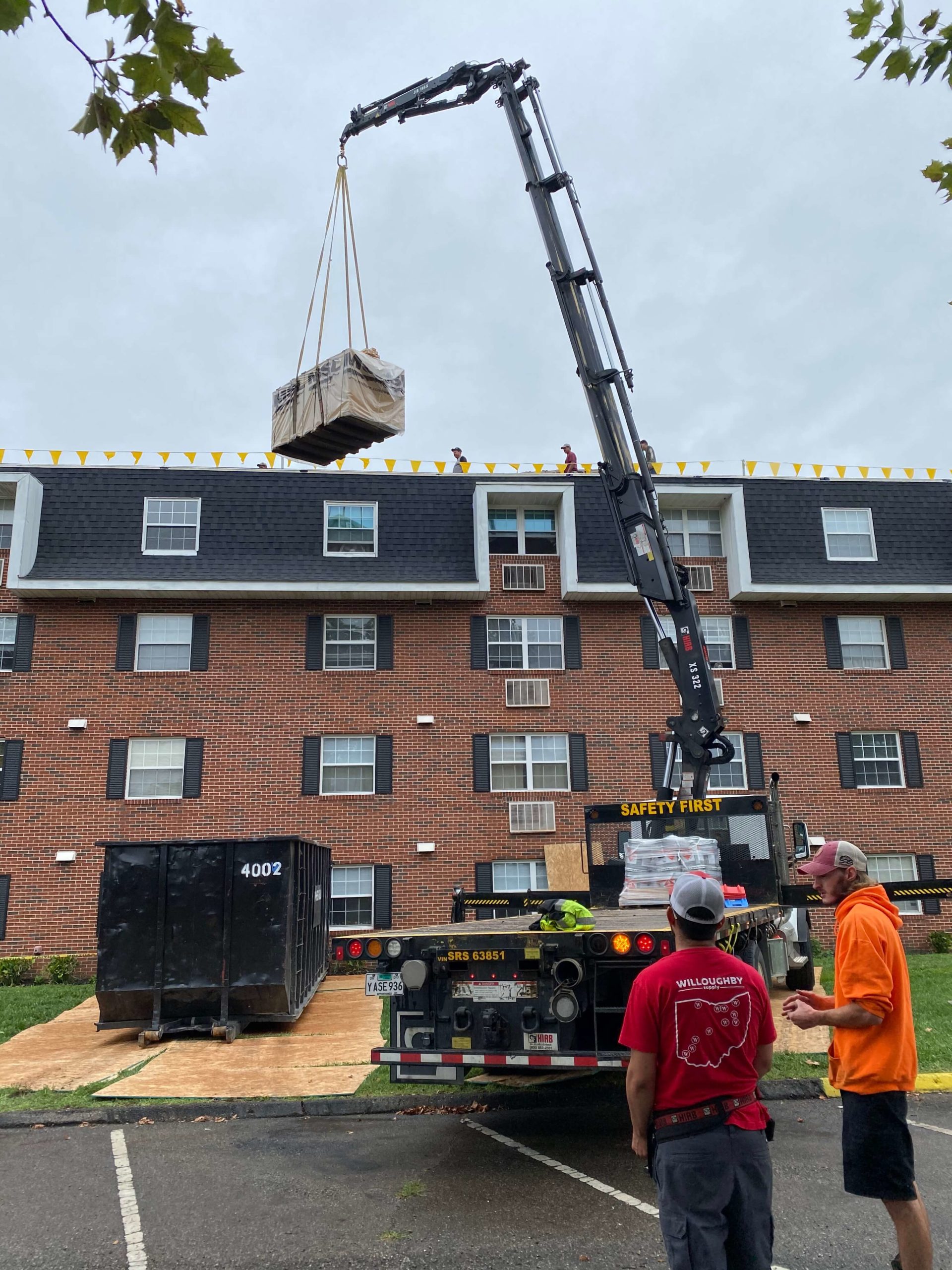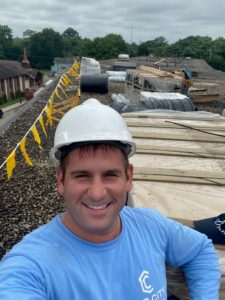
A flat roof is a great choice for commercial roofing given the flexibility it offers. However, a flat roof carries with it the risk of leaks and repairs along with some limitations on design just like any other roof.
So what is a flat roof? A flat roof is not actually flat; it a slight roof pitch that ranges between 1/4 to 1/2 inch downslope per foot, which is steep enough for water to drain efficiently. On the other hand, such a slight pitch can be a problem if the flat roof construction is not precisely completed.
There are modern solutions that help solve the flat roofs challenges. There are types of flat roof materials that are used to build flat roofs in order to avoid the issues that come with roofing flat, or nearly flat surfaces. A flat roof usually has a traditional hot-mopped, built-up roof that eventually leaks and needs repairs.
Before we tell you the best flat surface material, it’s best to understand the different options that are available. Flat roof materials include some great choices like rubber roofs or rubberized roofing, tar roofs, modified bitumen, ethylene propylene diene monomer, and there are terms like single ply that must be defined and understood before making a proper decision. Flat roofs have been covered with these roof materials for years, and each one is a fine choice, but each has limitations. That being said, the most common flat roof materials widely available on the market are:
1. Built-Up Roof (BUR)
A BUR is the oldest “modern” method of covering flat roofs. Dating back 120 years, BUR solved many roof problems including the low pitch roof problem, and was the best solution for many years. As is obvious from the name, there are several flat roof materials in the BUR that include roofing felt impregnated with asphalt. Additionally, the felt is also entrenched in bitumen, which is applied using a hot mop. If you’ve ever seen old black and white pictures of crews working on flat roofs, they were likely piling on the bitumen with a hot mop.
The purpose of the coal tar pitch or hot-applied asphalt is to blend the soaked roof felt. This results in a monolithic roof membrane. The process continues until there are multiple layers creating two to four piles of assembled thickness. Finally, crushed stone granules are laid out as a layer on top of the hot tar. This protects the roof from harmful UV lights and harsh weather. In the end, the roof consists of multiple material layers that blend together into a rudimentary flat roofing system.
2. Modified Bitumen Roof
In the 1960s, the built-up roof was no longer in favor with contractors and new materials for flat roofing were developed. Modified bitumen was the first alternative to be developed, and was immediately the best flat top roof material on the market at that time. At the time, modified bitumen was an upgraded design that improved upon the built-up roof technology by adding polymer (modified bitumen) reinforced cap sheets. Depending on the project, a modified bitumen roof can be installed using different methods. The methods include hot, cold, and torch applied or self-adhered.
The additional polymer in the cap sheets gives the roof the elasticity it needs for harsh temperatures. The most commonly used polymer is atactic polypropylene (APP) and styrene butadiene styrene (SBS). The APP sheets are installed using a torch while SBS is installed using a cold adhesive. This is still a good roofing material choice, but is no longer the top choice for flat roofs by modern contractors.
3. Membrane Roofing
This the most recent technology among the different types of flat roofing, and is a popular choice of many modern commercial buildings. The technical name is plastomeric or elastomeric roofing membrane. You can find a single ply roof in ethylene propylene diene monomer (EPDM), Neoprene, PVC, Polymer-modified bitumens, and Chlorinated polyethylene. EPDM is a rubber roofing material.
Synthetic EPDM rubber is the most common single-layer roof available on the market today, and it is used in both commercial and residential properties. EPDM sheets can be as thin as 30 millimeters and as thick as 60 millimeters. Since the the sheets are made of rubber, they can handle temperature changes really well, and their flexibility definitely puts them in the running for best flat roof material when compared to built up roofs.
What is Roofing Membrane?
When considering modern, single ply roofs, the goal is to create a long lasting, flexible, durable roofing system that needs very little maintenance. When choosing material and between the types of flat roofs, the options for a complete roofing system are quite extensive but still limited. No material, even EPDM rubber is perfect. No roofing system is perfect, just like any other building material. Each type of system has its own pros and cons with a lifespan that differs according to material and construction. There is usually a best choice for each situation, so we’ll compare each modern material to help each customer make the best decision for their situation. Modern flat roofs are covered with long lasting, durable roofing membrane. Here are the different options:
Modified Bitumen
This roof is the modern version of the BUR. The modified bitumen roof is installed in multiple layers and each surface is torched below one quarter turn of the roll. This process should be done only by professionals and takes a lot of effort and special tools, not to mention skill. The cold-roll technology option is now an option as well, but it additionally requires an application of roofing tar. A modified bitumen roof will cost you around $5.50 to $11.50 per square foot and will last for about 10 to 20 years. It is a good choice for a roofing material as it has been used for many years and for the most part, any contractor will be able to provide a rock solid estimate of how long a MB roof will last in any given situation.
EPDM Rubber
An EPDM rubber roof is a cheaper alternative to PVC and TPO (we’ll discuss these soon) roofing. This is the most commonly used roof membrane in commercial and residential roofs for its age and middle of the road functionality.
The seams of EPDM rubber membrane roofing are usually the point of failure in EPDM rubber roofs. Manufacturers minimize or avoid seams altogether while manufacturing the rubber membranes. The size of a typical EPDM rubber membrane can reach 50′ wide and 200′ long.
While a huge roll of EPDM membrane is difficult to handle during installation, it a great way to avoid leaks at the seams because there simply aren’t as many. An EPDM rubber membrane also requires an insulation layer between the roof deck and the membrane, just like the other roofing systems. EPDM membranes are made with dark colors to absorb more solar energy, which makes this an energy-efficient option. An EPDM rubber membrane costs around $6.50 to $12.50 per square foot and will last about 10 to 15 years. Remember, the upfront cost may be less with this type of material, but it will definitely not last as long as the others so the long term cost will usually even out, depending on how long an occupant plans to own a building. Think of a car tire. After a while, the rubber just doesn’t hold together well and can begin to break down, it’s the same with this type of material. That said, it’s a good choice, but not if a customer plans to own their building for 20-30 years or more.
PVC Membrane
Polyvinyl chloride (PVC), is a single-layer roofing membrane that is well known for its longevity, durability, and energy efficiency. PVC is a great material choice because with proper installation technique, a customer will be ensured a permanent bond due to the hot air weld. In fact, proper technique with this roofing material will ensure that the seams are stronger than the rest of the membrane itself. Used on both residential and commercial properties, a PVC roof has proven to last over 30 years in the right conditions.
Generally, 50 millimeter thick PVC membrane is used for residential roofs and between 60 to 80 millimeters for a commercial property. In order to make the roof energy-efficient, an insulation board in installed first. Installers ensure that the roof is fully glued to the roof deck in order to prevent any possible wind uplift. However, this will cost more than a PVC membrane attached mechanically. Depending on the membrane type, roof accessibility, installer, project scope, and location, a PVC roof will usually cost somewhere between $7.50 to $15.00 per square foot. The price per square foot also depends on the property, with commercial property costing more than residential. PVC roofs will usually last anywhere from 15 to 30+ years. Newer PVC technology and testing has allowed for roofs that last longer and are more durable than the first PVC roofs that were ever installed. Keep in mind that as the name implies, PVC is still plastic. There’s always the danger that it will warp or crack in extreme hot or cold weather conditions.
TPO Roofing Membrane
Thermoplastic polyolefin (TPO) is another single-ply roofing membrane that offers good, long-lasting overall performance for the money. Since the early 1990s, TPO roofing has been improving and has always performed well. TPO is also installed using a hot air weld but the composition is different from a PVC roof.
The roof deck is layered with insulation boards and then the TPO roll is installed. The method used to install the roof is self-adhesive. This roof will cost you around $6.50 to $14.00 per square foot and used to last anywhere from 7 to 20 years. However, because of the technology improvements mentioned earlier, a more modern TPO roof installed with the latest materials will more likely last for 20-30 years. For the durability, longevity, and price, TPO roofing is probably the best material for a flat roof and it continues to become an even better choice as technology improves even more.
Keep in mind, like the other single ply roofing systems, it’s best to tear the old roof off entirely to the studs, replace the insulation, make necessary repairs, and install the new roof fresh. However, this is not required and the now system can go over top of the old one, but likely with a reduced warranty and lifespan, but certainly cost as well.
Spray-On Roof Coating
A common way to extend the life of an existing roof is with a spray on coating. A spray on coating can not only extend the lifespan but also help improve the energy-efficiency of the roof as well. There’s not much involved in the spray process other than the material, but it’s very important to be sure that the roof has been thoroughly and completely cleaned prior to application for best and longest lasting results. The spray should be done evenly around the surface of the entire roof.
The cost of this varies because of the material being used. Polyurethane foam can be used for as low as $3.50 per square foot and acrylic for $6.50. Silicon is priced higher as it comes under the premium spray application and will cost around $7.50 to $12.50+ per square foot and this can last up to 20 years.
Local Flat Roof Contractor

It can be a challenge to choose the right material for your roof. Many factors must be taken into account, including your budget, the expected lifespan, and
the aesthetics. It would certainly be a poor choice to put a 10 year roof on a building that you plan to own for 50 more years, but it would be just as poor of a choice to put a top of the line 30 year roof on a building that will be torn down in 5 years.
Be sure to call an expert before getting started. There’s nothing more helpful than an experienced, local roofing crew that has the knowledge and expertise to help you make the best choice for your situation.

